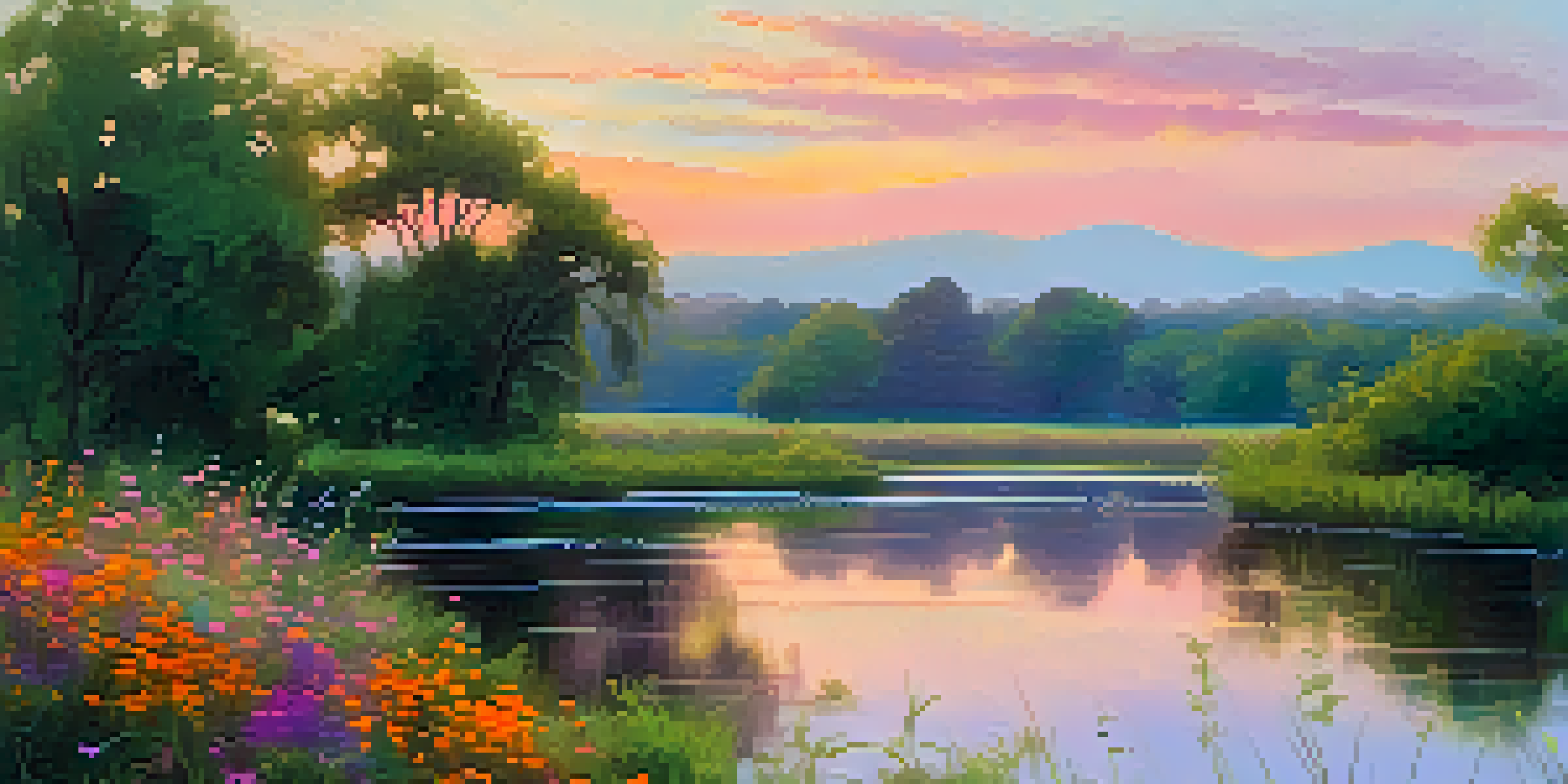Impressionism and Its Impact on Landscape Painting

Understanding Impressionism: A Revolutionary Art Movement
Impressionism emerged in the late 19th century as a bold departure from traditional painting styles. Artists like Claude Monet and Pierre-Auguste Renoir sought to capture the fleeting effects of light and atmosphere in their work. This innovative approach emphasized spontaneity and the artist's personal perception, which was a stark contrast to the meticulous details favored in academic art. The movement laid the groundwork for modern art, encouraging artists to explore beyond conventional boundaries.
Impressionism is not a movement but a way of seeing.
In essence, Impressionism was about capturing a moment in time, much like a photograph but infused with emotion and movement. These artists often painted en plein air, or outdoors, to directly observe their subjects, allowing nature's ever-changing light to influence their palettes. This shift in technique not only changed how landscapes were represented but also how viewers experienced them. The beauty of nature became a dynamic canvas for personal expression.
By breaking away from rigid structures, Impressionist artists invited viewers to engage with their work in new ways. The use of vibrant colors and loose brushwork created a sense of immediacy and intimacy. As a result, the Impressionist movement not only redefined landscape painting but also inspired future generations to embrace creativity and innovation in their art.
Key Characteristics of Impressionist Landscape Painting
Impressionist landscape painting is characterized by its focus on light, color, and movement. Artists employed techniques like broken brush strokes and a lighter palette to create a shimmering effect that mimics the play of sunlight on water or foliage. This method allowed them to convey the essence of a scene rather than its precise details, inviting viewers to experience nature's beauty in a more visceral way.

The representation of landscapes was often influenced by the time of day and weather conditions, further illustrating the transitory nature of light. For instance, Monet's series of haystacks and Rouen Cathedral showcased how the same subject could change dramatically under different lighting. This attention to atmospheric conditions not only enhanced the visual appeal but also emphasized the emotional resonance of the landscape.
Impressionism Redefined Art
Impressionism broke away from traditional painting, emphasizing light, color, and personal perception to create a dynamic representation of nature.
Moreover, Impressionist artists often depicted scenes of everyday life, capturing the interplay of people and nature. This approach made landscapes feel more relatable, as viewers could see themselves in these vibrant depictions of parks, rivers, and gardens. By blending human experience with the beauty of the natural world, Impressionists created a harmonious dialogue between the two.
Notable Impressionist Landscape Painters and Their Works
Claude Monet is perhaps the most famous Impressionist landscape painter, known for his iconic works like 'Impression, Sunrise' and 'Water Lilies.' His ability to capture the nuances of light and color transformed how landscapes were portrayed. Monet's gardens in Giverny became a muse for countless paintings, showcasing his passion for blending nature with artistic expression.
The painter of the future will be a painter of light.
Another significant figure is Camille Pissarro, who often painted rural landscapes and scenes of peasant life. His works, like 'The Boulevard Montmartre, Spring' and 'The Harvest,' reflect his keen observation of everyday life, infused with the luminescence characteristic of Impressionism. Pissarro's emphasis on community and nature made his landscapes not just visually appealing but also socially relevant.
Lastly, Alfred Sisley is celebrated for his serene depictions of the French countryside. His paintings often featured rivers and bridges, imbued with a sense of tranquility. Works like 'The Bridge at Villeneuve-la-Garenne' showcase his mastery of light and atmosphere, further cementing his role as a pivotal contributor to the landscape painting within the Impressionist movement.
The Role of Color and Light in Impressionist Landscapes
Color and light are central themes in Impressionist landscape painting, where artists experimented with vibrant hues to evoke emotion. They often used complementary colors to create contrast, allowing light to appear more dynamic and alive. This innovative use of color transformed landscapes into colorful tapestries that engaged viewers on multiple sensory levels.
The effects of light were meticulously studied by Impressionist painters, who understood that light can change the perception of color throughout the day. For instance, the golden hues of a sunset can evoke warmth and nostalgia, while the cool tones of early morning can convey calmness and serenity. By capturing these subtle variations, artists were able to tell a story through their landscapes, inviting viewers to immerse themselves in the moment.
Color and Light as Key Elements
The innovative use of color and light in Impressionist landscapes evokes emotion and captures the essence of a moment in time.
Additionally, the interplay between shadow and light added depth to their compositions. Instead of using black to depict shadows, Impressionists often incorporated colors from their surroundings, creating a more realistic representation of nature. This technique not only enhanced the three-dimensionality of their paintings but also contributed to the overall emotional impact of the artwork.
The Impact of Impressionism on Future Art Movements
The legacy of Impressionism extends far beyond its own era, influencing numerous art movements that followed. Post-Impressionism, for example, built on the foundations laid by Impressionists while further exploring color and form. Artists like Vincent van Gogh and Paul Cézanne took the emotional intensity of Impressionism and infused their works with distinct personal styles, pushing the boundaries of what landscape painting could convey.
Moreover, the Abstract Expressionist movement drew inspiration from the spontaneity and emotional depth of Impressionism. Artists such as Jackson Pollock and Mark Rothko emphasized personal expression and the act of painting itself, mirroring the way Impressionists sought to convey their immediate experiences of nature. This connection highlights how the principles of Impressionism continue to resonate in contemporary art.
Furthermore, Impressionism's focus on subjective perception paved the way for modern and contemporary art practices. Artists began to explore abstraction, minimalism, and conceptual art, often using landscapes as a starting point to delve into broader themes of identity and existence. Thus, Impressionism not only revolutionized landscape painting but also laid the groundwork for artistic exploration in the 20th century and beyond.
Why Impressionism Still Resonates Today
The enduring appeal of Impressionism lies in its ability to connect with viewers on a personal level. The spontaneous brushwork and vibrant colors evoke feelings of joy, nostalgia, and tranquility, making these artworks timeless treasures. Whether seen in galleries or reproduced in homes, Impressionist landscapes invite us to pause and appreciate the beauty of the world around us.
In a fast-paced, digital age, the essence of Impressionism serves as a reminder to slow down and savor the moment. Its focus on natural beauty encourages us to reconnect with our surroundings, whether through a leisurely walk in the park or a quiet moment by the water. This intrinsic connection to nature and emotion makes Impressionism relevant and relatable to contemporary audiences.
Legacy Influences Future Art
Impressionism laid the groundwork for modern art movements, inspiring artists to explore abstraction and subjective perception.
Additionally, Impressionist landscapes continue to inspire artists and art enthusiasts alike. The techniques and philosophies introduced by Impressionism have become integral to art education, influencing how new generations approach painting. As we explore and reinterpret these principles, the spirit of Impressionism lives on, shaping the future of landscape painting and art as a whole.
Conclusion: The Lasting Legacy of Impressionism in Art
In conclusion, Impressionism has left an indelible mark on the world of landscape painting. By prioritizing personal perception and the beauty of light and color, Impressionist artists transformed how we view the natural world. Their innovative techniques and emotional depth continue to resonate, inspiring both artists and admirers alike.
The movement not only revolutionized art in its time but also paved the way for future explorations in creativity and expression. As we reflect on the impact of Impressionism, we recognize its role in shaping modern art and our understanding of beauty. Each brushstroke and vibrant hue invites us to see the world through the eyes of the artist, creating a timeless dialogue between nature and humanity.

Ultimately, the legacy of Impressionism serves as a testament to the power of art to evoke emotion and foster connection. As we continue to explore landscapes and the many ways they can be represented, we honor the trailblazers of Impressionism who dared to see the world differently and encouraged us to do the same.